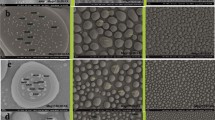Abstract
Thiophene and pyrrole copolymer was synthesized by chemical oxidation in the presence of anhydrous FeCl3 in acetonitrile at 0 °C. Characterizations of the obtained copolymers were performed by cyclic voltammetry (CV), UV–Vis spectroscopy, Fourier transform infrared spectroscopy (FT-IR), field emission scanning electron microscopy (FE-SEM), differential scanning calorimetry (DSC) and thermogravimetry analysis (TGA). By using chemical oxidative method and based on the results, the copolymer (P(Th-co-Py)) formation was confirmed without any traces for the homopolymers formation. At the undoped state of the copolymer, the π–π* transition absorption peak was located at 629 nm and the optical band gap (Eg) was calculated as 1.97 eV. The effect of the copolymerization time and the comonomers molar ratio on the chemical and physical properties of the P(Th-co-Py) was investigated. The optimum time for copolymerization was evaluated as 6 h and mass specific capacitance (Cms) for P(Th-co-Py) with comonomer ratio of 60Th/40Py was obtained to be 73.7 F/g, falling in the range of supercapacitance.














Similar content being viewed by others
References
Ma W, Iyer PK, Gong X, Liu B, Moses D, Bazan GC, Heeger AJ (2005) Water/methanol-soluble conjugated copolymer as an electron-transport layer in polymer light-emitting diodes. Adv Mater 17:274. https://doi.org/10.1002/adma.200400963
Camaioni N, Tinti F, Franco L, Fabris M, Toffoletti A, Ruzzi M, Montanari L, Bonoldi L, Pellegrino A, Calabrese A (2012) Effect of residual catalyst on solar cells made of a fluorene-thiophene-benzothiadiazole copolymer as electron-donor: a combined electrical and photophysical study. Org Electron 13:550–559. https://doi.org/10.1016/j.orgel.2011.12.005
Zhao G, He Y, He C, Fan H, Zhao Y, Li Y (2011) Photovoltaic properties of poly(benzothiadiazole-thiophene-co-bithiophene) as donor in polymer solar cells. Sol Energy Mater Sol Cells 95:704–711. https://doi.org/10.1016/j.solmat.2010.10.007
Aydin M, Esat B, Kilic C, Kose ME, Ata A, Yilmaz F (2011) A polythiophene derivative bearing TEMPO as a cathode material for rechargeable batteries. Eur Polym J 47:2283–2294. https://doi.org/10.1016/j.eurpolymj.2011.09.002
Waghuley SA, Yenorkar SM, Yawale SS, Yawale SP (2008) Application of chemically synthesized conducting polymer-polypyrrole as a carbon dioxide gas sensor. Sens Actuators B 128:366–373. https://doi.org/10.1016/j.snb.2007.06.023
Cakmakci I, Duran B, Bereket G (2013) Influence of electrochemically prepared poly(pyrrole-co-N-methyl pyrrole) and poly(pyrrole)/poly(N-methyl pyrrole) composites on corrosion behavior of copper in acidic medium. Prog Org Coat 76:70–77. https://doi.org/10.1016/j.porgcoat.2012.08.015
Koezuka H, Etoh S (1983) Chemical synthesis of thiophene-pyrrole copolymer. J Appl Phys 54:2511–2516
Sato M, Yamamaka S, Nakaya J, Hyodo K (1994) Electrochemical copolymerization of aniline with o-aminobenzonitrile. Electrochem Acta 39:2159–2167. https://doi.org/10.1016/0013-4686(94)E0159-W
Tourillon G, Garnier F (1984) Morphology of conducting organic polymers: Polythiophene and poly(3-methyl thiophene). J Polym Sci Polym Phys 22:33–39. https://doi.org/10.1002/pol.1984.180220103
Naitoh S (1987) Poly(thienylpyrrole)-preparation and properties. Synth Metals 18:237–240. https://doi.org/10.1016/0379-6779(87)90886-1
Mcleod GG, Mahboubian-Jones MGB, Pethrick RA, Watson SD, Truong ND, Galin JC (1986) Electrosynthesis and characterization of polypyrrole in the presence of 2,5-di-(2-thienyl)-pyrrole (SNS). J Francois Polym 27:455–458
Lazzaroni R, Riga J, Verbist J, Christiaens L, Renson M (1985) Electrochemical synthesis and preliminary characterization of poly(thieno[3,2-b]pyrrole). J Chem Soc Chem Commun 0:999–1000. https://doi.org/10.1039/C39850000999
Schweiger LF, Ryder KS, Morris DG, Glidle A, Cooper JM (2000) Strategies towards functionalized electronically conducting organic copolymers. J Materials 10:107–114. https://doi.org/10.1039/A904187G
Liang QY, Neoh KG, Kang ET, Tan KL, Wong HK (1992) Charge transfer interactions in bithiophene-pyrrole and bithiophene-aniline copolymers. Eur Polym J 28:755–763. https://doi.org/10.1016/0014-3057(92)90079-H
Kuwabata S, Ito S, Yoneyama H (1988) Copolymerization of pyrrole and thiophene by electrochemical oxidation and electrochemical behavior of the resulting copolymers. J Electrochem Soc 135:1691–1695. https://doi.org/10.1149/1.2096098
Li X, Lu M, Li H (2002) Electrochemical copolymerization of pyrrole and thiophene nanofibrils using template-synthesis method. J Appl Polym Sci 86:2403–2407. https://doi.org/10.1002/app.10893
Kamat SV, Puri V, Puri RK (2012) Room temperature synthesis and characterization of polythiophene thin films by chemical bath deposition (CBD). Mater Chem Phys 132:228–232. https://doi.org/10.1016/j.matchemphys.2011.11.044
Foroutani K, Pourabbas B, Sharif M, Fallahian M, Khademi S, Mohammadizadeh M (2014) In situ deposition of polythiophene nano particles on flexible transparent films: effect of the process conditions. Mater Sci Semicond Process 19:57–65. https://doi.org/10.1016/j.mssp.2013.11.012
Senthilkumar B, Thenamirtham P, Kalai Selvan R (2011) Structural and electrochemical properties of polythiophene. Appl Surf Sci 257:9063–9067. https://doi.org/10.1016/j.apsusc.2011.05.100
Alakhras F, Holze R (2007) In situ UV–Vis-and FT-IR-spectroscopy of electrochemically synthesized furan–thiophene copolymers. Synth Met 157:109–119. https://doi.org/10.1016/j.synthmet.2006.12.011
Kaur A, Shpal I, Dhawan SK (2012) Tuning of EMI shielding properties of polypyrrole nanoparticles with surfactant concentration. Synth Met 162:1471–1477. https://doi.org/10.1016/j.synthmet.2012.05.012
Dubal DP, Patil SV, Kim WB, Lokhande CD (2011) Supercapacitors based on electrochemically deposited polypyrrole nanobricks. Mater Lett 65:2628–2631. https://doi.org/10.1016/j.matlet.2011.05.114
Yue R, Chen S, Liu C, Lu B, Xu J, Wang J, Liu G (2012) Synthesis, characterization, and thermoelectric properties of a conducting copolymer of 1, 12-bis (carbazolyl) dodecane and thieno[3, 2-b]thiophene. J Solid State Electrochem 16:117–126. https://doi.org/10.1007/s10008-011-1292-0
Basavaraja C, Kim NR, Jo EA, Pierson R, Huh DS, Venkataraman A (2009) Transport properties of polypyrrole films doped with sulphonic acids. Bull Korean Chem Soc 30:2702–2706
Karima MR, Lim KT, Lee CJ, Lee MS (2007) A facile synthesis of polythiophene nanowires. Synth Met 157:1008–1012. https://doi.org/10.1016/j.synthmet.2007.10.010
Berson S, Cecioni S, Billon M, Kervella Y, Bettignies RD, Bailly SV, Guillerez SP (2010) Effect of carbonitrile and hexyloxy substituents on alternated copolymer of polythiophene-Performances in photovoltaic cells. Sol Energy Mater Sol Cells 94:699–708. https://doi.org/10.1016/j.solmat.2009.12.028
Wallace GG, Spinks GM, Kane-Maguire LAP, Teasdale PR (2009) Conductive electriactive polymers, 3rd edn. Taylor & Francis Group, Milton Park, Abingdon-on-Thames, Oxfordshire United Kingdom, pp 13–14
Acknowledgements
The authors wish acknowledge Iran Nanotechnology Initiative Council for their partial financial support through the Contract Number: 47062.
Author information
Authors and Affiliations
Corresponding author
Rights and permissions
About this article
Cite this article
Khademi, S., Pourabbas, B. & Foroutani, K. Synthesis and characterization of poly(thiophene-co-pyrrole) conducting copolymer nanoparticles via chemical oxidative polymerization. Polym. Bull. 75, 4291–4309 (2018). https://doi.org/10.1007/s00289-017-2264-z
Received:
Revised:
Accepted:
Published:
Issue Date:
DOI: https://doi.org/10.1007/s00289-017-2264-z




